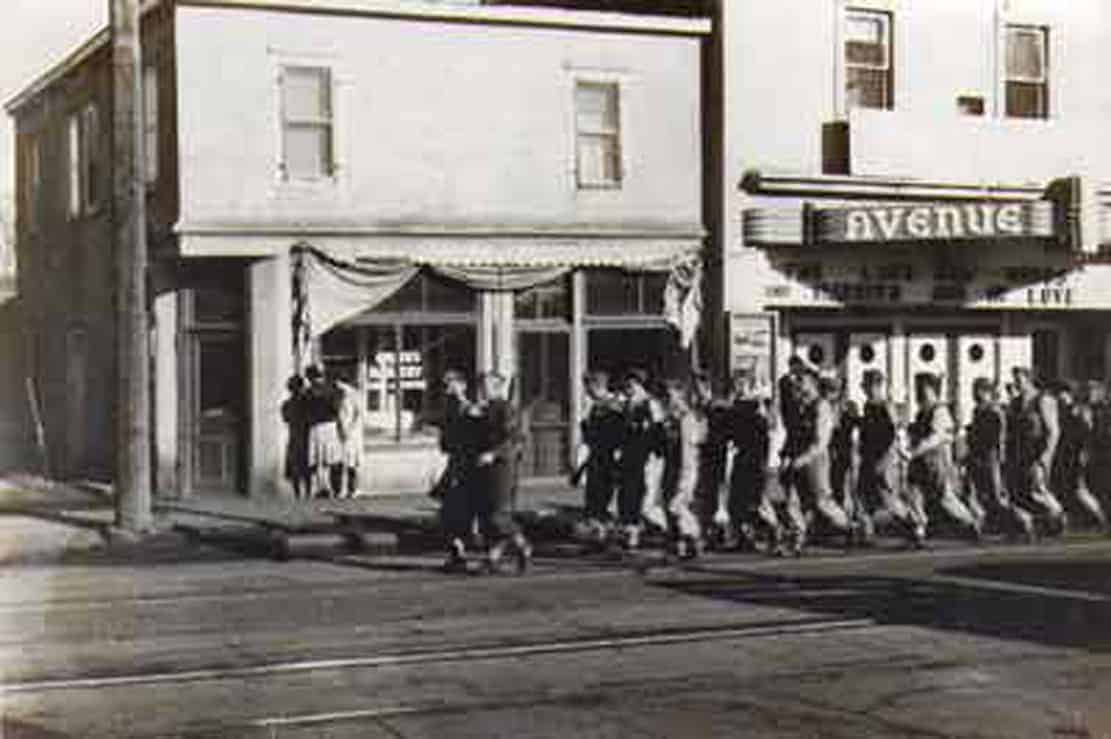Tales of a wartime photo: what happened here
This 1942 photo of army recruits walking down 118 Avenue is a good representation of popular culture in Edmonton during the Second World War.
The Pearl Harbour attack had occurred on Dec. 7, 1941. Lesser known is the heavy loss of Canadian troops during the Japanese invasion of Hong Kong beginning Dec. 8, 1941. The brief but disastrous Dieppe raid on Aug. 19, 1942, was devastating. Of the 4,963 Canadians who left England for the operation, only 2,210 returned, with several wounded.
Canada had been at war since Sept. 10, 1939, and the words “don’t you know there’s a war on?” were frequently heard. Canadians were subjected to strong recruitment propaganda. These men are making an open display of patriotism, and were likely going to the Prince of Wales Armoury southwest of 118 Avenue. Gasoline and rubber were rationed, as Germany and Japan occupied key trade routes in the Middle East and the Pacific. Cars and streetcars were available, but people walked to support the war effort.

The men in this photo had likely volunteered for overseas service. Introduced in mid-1940, the National Resources Mobilization Act (NRMA) required national registration of eligible men and authorized conscription for home defence but not overseas action. From April 1941, NRMA men were required to serve the rest of the war on home defence duties.
The NRMA men, or “zombies” as they were popularly known, were despised in English Canada. They did not do active army service with the enemy. At times subjected to beatings, it’s unlikely these men would have made a strong public display of their military status.
Behind these men to the right is the Avenue Theatre, which was enjoying a period of popularity. During the Depression, people often listened to radio or played cards for entertainment. Prosperity arising from the Second World War allowed people to go to movies and eat outside the home. Despite rationing, the war effort provided well-paid employment in war plants, shipbuilding, and aircraft production. Many women worked in non-traditional occupations to fill the labour shortage created by recruitment.
The building to the left is the Smith Bakery, opened in 1938 by Francis Smith. The baker initially occupied the whole building, but when Canada went to war in 1939, Smith began renting the upper floor to a succession of single men.
People came to Edmonton in droves, both for work and army service. In Six War Years 1939-45, author Barry Broadfoot quotes one of his interview subjects as saying “You tried every way you could to get a place to live,” referring to Edmonton at the time.
While searching through military records, I uncovered the story of Ernest Hilker, who lived on the upper floor of Smith Bakery when this photo was taken. Hilker was a farmer’s son from Red Willow, Alberta. Fresh out of high school, he volunteered for overseas service in the Royal Canadian Air Force in late May 1941. Hilker told the recruiter he liked boxing, baseball, and photography. He became a flight sergeant in the 408 bomber squadron, which ran bombing raids over Germany. Hilker’s aircraft was lost on Jan. 3, 1943, and his grave is unknown.
If you can identify anyone in this photo, please contact Alberta Avenue Community League at 780.477.2773.







